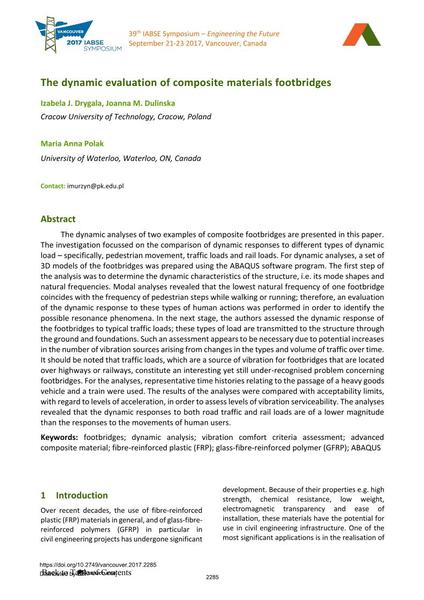The dynamic evaluation of composite materials footbridges

|
|
|||||||||||
Détails bibliographiques
| Auteur(s): |
Izabela Drygala
(Cracow University of Technology, Cracow, Poland)
Joanna M. Dulinska (Cracow University of Technology, Cracow, Poland) Maria Anna Polak (University of Waterloo, Waterloo, ON, Canada) |
||||
|---|---|---|---|---|---|
| Médium: | papier de conférence | ||||
| Langue(s): | anglais | ||||
| Conférence: | IABSE Symposium: Engineering the Future, Vancouver, Canada, 21-23 September 2017 | ||||
| Publié dans: | IABSE Symposium Vancouver 2017 | ||||
|
|||||
| Page(s): | 2285-2292 | ||||
| Nombre total de pages (du PDF): | 8 | ||||
| Année: | 2017 | ||||
| DOI: | 10.2749/vancouver.2017.2285 | ||||
| Abstrait: |
The dynamic analyses of two examples of composite footbridges are presented in this paper. The investigation focussed on the comparison of dynamic responses to different types of dynamic load – specifically, pedestrian movement, traffic loads and rail loads. For dynamic analyses, a set of 3D models of the footbridges was prepared using the ABAQUS software program. The first step of the analysis was to determine the dynamic characteristics of the structure, i.e. its mode shapes and natural frequencies. Modal analyses revealed that the lowest natural frequency of one footbridge coincides with the frequency of pedestrian steps while walking or running; therefore, an evaluation of the dynamic response to these types of human actions was performed in order to identify the possible resonance phenomena. In the next stage, the authors assessed the dynamic response of the footbridges to typical traffic loads; these types of load are transmitted to the structure through the ground and foundations. Such an assessment appears to be necessary due to potential increases in the number of vibration sources arising from changes in the types and volume of traffic over time. It should be noted that traffic loads, which are a source of vibration for footbridges that are located over highways or railways, constitute an interesting yet still under-recognised problem concerning footbridges. For the analyses, representative time histories relating to the passage of a heavy goods vehicle and a train were used. The results of the analyses were compared with acceptability limits, with regard to levels of acceleration, in order to assess levels of vibration serviceability. The analyses revealed that the dynamic responses to both road traffic and rail loads are of a lower magnitude than the responses to the movements of human users. |
||||
| Mots-clé: |
passerelles ABAQUS
|
||||
